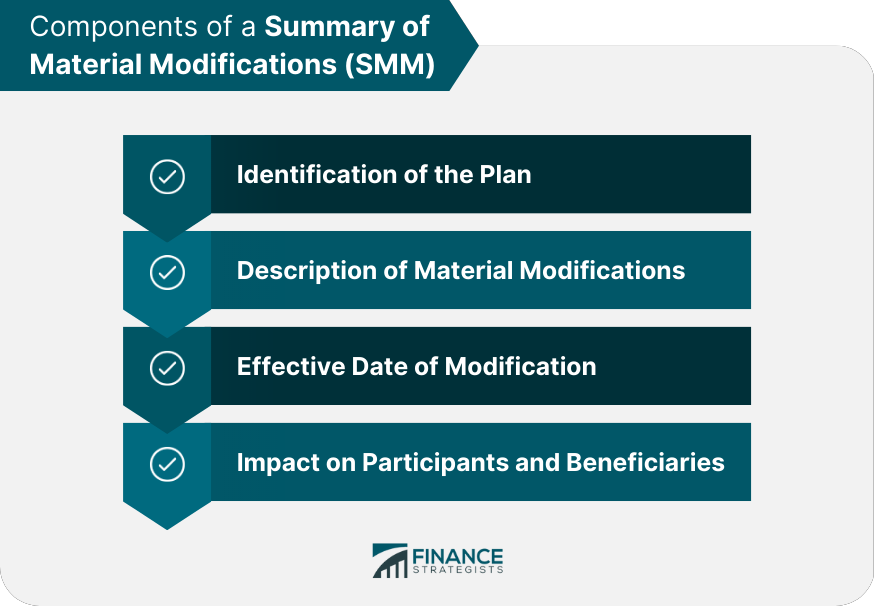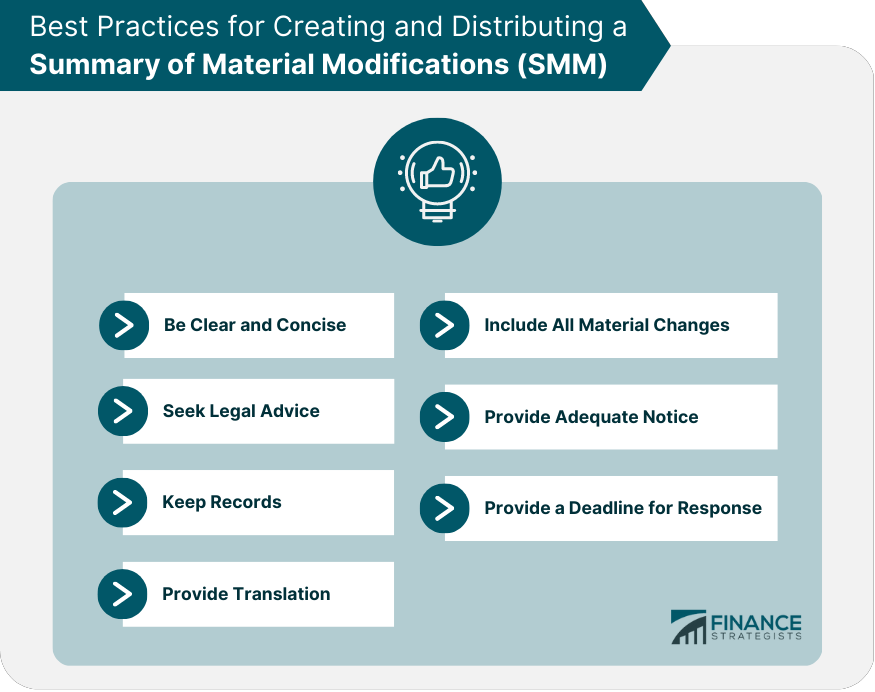A Summary of Material Modifications is a document that provides essential information about significant changes made to an employee benefit plan, such as retirement or health plans, governed by the Employee Retirement Income Security Act (ERISA). It is designed to inform plan participants and beneficiaries about modifications that may impact their rights, benefits, or responsibilities under the plan. SMMs serve to maintain transparency and clear communication between plan sponsors or administrators and plan participants. By keeping participants informed about material changes, SMMs help them make informed decisions about their benefits and financial planning. ERISA regulates employee benefit plans in the United States and mandates the creation and distribution of SMMs to ensure that participants are aware of any material modifications made to their plans. The SMM should clearly indicate the name of the employee benefit plan to which the modifications apply. Include the plan number as assigned by the plan sponsor or administrator for easy reference. Identify the plan sponsor or administrator responsible for overseeing the plan and implementing the modifications. Outline any alterations made to the benefits provided under the plan, such as new offerings, eliminated benefits, or adjustments to existing benefits. Detail any modifications made to the eligibility criteria for participating in the plan, including age, service, or employment status requirements. Explain any changes made to the vesting schedules, which determine when participants gain full ownership of employer-contributed assets. Describe any adjustments to the maximum or minimum amounts that participants or employers can contribute to the plan. Clarify any modifications to the terms, conditions, or availability of loans and distributions from the plan. Specify the date on which the material modifications will take effect, as well as any conditions or transitional provisions related to the implementation. Explain any adjustments to the rights and responsibilities of participants and beneficiaries, such as new obligations, reporting requirements, or disclosure rules. Describe the potential impact of the modifications on participants' contributions or benefits, including any changes to contribution rates, matching contributions, or benefit calculations. Detail any changes to the procedures for enrolling in the plan, including deadlines, required forms, or supporting documentation. Clarify any alterations to the processes for filing claims or appealing denials, including new timelines, submission requirements, or review procedures. Plan administrators may distribute SMMs as hard copies mailed directly to participants' homes. SMMs can also be delivered electronically via email or other secure electronic means, provided that participants have given their consent to receive electronic communications. SMMs may be made available on the plan's website or online portal, as long as participants are notified of the updates and can access the information easily. ERISA requires that SMMs be distributed to participants within 210 days following the end of the plan year in which the modifications were adopted. In certain cases, such as modifications due to legal or regulatory changes, SMMs may need to be distributed more promptly to comply with specific deadlines or requirements. Failure to provide SMMs within the specified time frame can result in penalties or fines imposed by the Department of Labor (DOL) and may expose plan administrators to potential legal action by participants. The SMM should be written in a clear and concise language that is easy to understand. It should avoid using technical jargon or complex terms that may confuse employees. The SMM should include all material changes to the employee benefit plan, including changes to the plan's terms and conditions, eligibility requirements, benefits, and cost-sharing provisions. Employers should provide adequate notice to employees of the changes to the plan and the availability of the SMM. This could include sending the SMM by mail or email, posting it on the company's intranet, or distributing it in person at company meetings. The SMM should provide employees with a deadline for responding to the changes, if applicable. For example, if employees are required to enroll in or opt-out of a new benefit option, the SMM should provide a deadline for doing so. Employers should seek legal advice to ensure that the SMM complies with all relevant laws and regulations, such as the Employee Retirement Income Security Act (ERISA). Employers should keep a record of all SMMs distributed to employees and maintain copies of previous versions of the SMM in case they need to reference them in the future. If employees speak languages other than English, employers should provide a translation of the SMM in their language to ensure they fully understand the changes to the employee benefit plan. SMMs play a critical role in maintaining transparency and ensuring compliance with ERISA requirements for employee benefit plans. By keeping participants informed about material modifications, SMMs help promote trust, engagement, and informed decision-making. SMMs enable participants to stay up-to-date with any changes to their benefit plans and make informed decisions regarding their contributions, investments, and overall financial planning. Plan sponsors, administrators, and participants must continue to prioritize education and awareness about SMM requirements to ensure that all parties remain informed and compliant with ERISA regulations.What Is a Summary of Material Modifications (SMM)?
Components of a Summary of Material Modifications
Identification of the Plan
Plan Name
Plan Number
Plan Sponsor or Administrator
Description of Material Modifications
Changes to Plan Benefits
Changes to Eligibility Requirements
Amendments to Vesting Schedules
Modifications to Contribution Limits
Adjustments to Plan Loans or Distributions
Effective Date of Modifications
Impact on Participants and Beneficiaries
Changes to Rights and Responsibilities
Adjustments to Contributions or Benefits
Updates to Enrollment Procedures
Modifications to Claims and Appeals Processes

Delivery and Timing of a Summary of Material Modifications
Delivery Methods
Mailed Hard Copies
Electronic Distribution
Plan Website or Portal
Timing Requirements
ERISA Guidelines
Special Circumstances and Exceptions
Penalties for Non-compliance
Best Practices for Creating and Distributing SMMs
Be Clear and Concise
Include All Material Changes
Provide Adequate Notice
Provide a Deadline for Response
Seek Legal Advice
Keep Records
Provide Translation

Conclusion
Importance of SMMs for Plan Transparency and Compliance
The Role of SMMs in Promoting Informed Decision-Making by Participants
Ongoing Need for Education and Awareness about SMM Requirements
Summary of Material Modifications (SMM) FAQs
A Summary of Material Modifications is a document that outlines any significant changes to an employee benefit plan. It provides plan participants with information about changes to their benefits, eligibility, coverage, or plan rules.
A plan administrator must provide a SMM to all plan participants within 210 days after the end of the plan year in which the change was made, or within 60 days after the change is adopted, whichever is later.
A SMM must include a summary of the changes made to the plan, the effective date of the changes, and any action that participants need to take in response to the changes.
The plan administrator is required to provide a SMM to all plan participants, including active employees, retirees, and beneficiaries.
A SMM is important because it provides plan participants with important information about changes to their benefits or plan rules. It ensures that participants are aware of any changes that may impact their coverage or eligibility and helps them make informed decisions about their benefits.
True Tamplin is a published author, public speaker, CEO of UpDigital, and founder of Finance Strategists.
True is a Certified Educator in Personal Finance (CEPF®), author of The Handy Financial Ratios Guide, a member of the Society for Advancing Business Editing and Writing, contributes to his financial education site, Finance Strategists, and has spoken to various financial communities such as the CFA Institute, as well as university students like his Alma mater, Biola University, where he received a bachelor of science in business and data analytics.
To learn more about True, visit his personal website or view his author profiles on Amazon, Nasdaq and Forbes.











